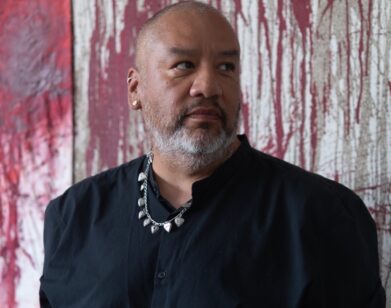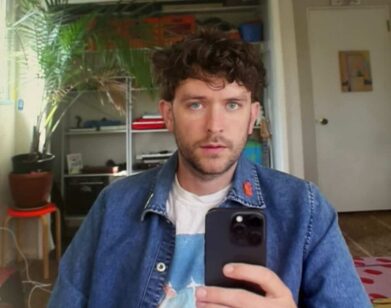The Luminous Johan Van Mullem
The monumental work of Belgian artist Johan Van Mullem evokes comparisons that might flatter and intimidate most artists to the point of discomfort: Goya, Rembrandt, Francis Bacon, and William Blake quickly come to mind. Though Van Mullem is adamant about his disinterest in using art history as a reference, he is open to the idea that these same artists may influence his work by way of a collective consciousness that survives from generation to generation. Van Mullem’s work deals almost exclusively with introspective psychological portraits that touch on science and technology, light and dark, youth and decay, our unfathomable origins and the endless possibilities for our future.
Van Mullem’s work will go on display this Thursday at C24 Gallery in Chelsea. This will be the artist’s first showing in the United States. The work, mostly oil-based ink on unprimed board, displays a striking luminosity; vibrant purple and crimson pigments float over rich blacks and earth tones, creating pieces that somehow feel both pristine and primordial.
When we got in contact with Johan Van Mullem, he was in his secluded studio, somewhere in the quaint suburbs of Brussels. We discussed his African origins, the philosophy of art, and its connection to our spiritual and metaphysical reality, as well as the finer points of portraiture and its direct influence on both the artist and the viewer.
KURT MCVEY: How much of your own personal and artistic sense of self is tied to a particular nationality or country of origin?
JOHAN VAN MULLEM: We are born and will die without truly understanding 99.99 percent of what our body and brain has seen, heard, and experienced in our short life. On one side, you have the brain selecting the images, thoughts, and feelings needed to act appropriately in society. How to properly feel alive is, in essence, a process shaped by our educational systems. On the other side, you have a million threads of emotional information stored in the human body; an amazing silent and unconscious world contained within. This exists before we even happen to be born. So this question is larger than my own traveling story, or the origin of my families. It flourishes first with my mother and father and seems to stop at my grandparents. What I do know is that both my father and grandfather were drawers and painters. That is the way to my origin. We are all just a union between yesterday and tomorrow.
MCVEY: If your father and grandfather were artists, surely you were exposed or influenced by the somewhat patriarchal nature of art and culture.
VAN MULLEM: Yes, I can see that some of my work is reminiscent of the Flemish school in its colors, light, and major expression, and yes I have Flemish origins [Van Mullem’s family is from Bruges], but I grew up in various countries—Congo, Tunisia, Sweden, Germany—and therefore I sometimes feel like a stateless person. I do have a strong link to my Flemish forefathers. When I hear poetry recited in Flemish, I cry. It’s pure emotion, without understanding truly why each word touches me, but the words know the way towards the depths, the abysses, and resources of my soul.
MCVEY: You have stated in the past that you tend to shun comparisons to classical art and artists, but can you tell us if living in the Congo and then Tunisia influenced your artistic style?
VAN MULLEM: I did have an African mask period, these large and spontaneous drawings done with black felt-tip pens, constructed like a labyrinth, undoubtedly an attempt to explore the history of my African birth and my first year growing up in the Congo, of which I of course remember nothing. [laughs] Was I exploring some dialogue between white skin and black ink? Were these images stored in my unconscious? I don’t know. I actually met someone who read my story in those drawings without knowing me well. It was amazing!
MCVEY: How old were you when you were living in Tunisia?
VAN MULLEM: Seven to 14 years old. It was there that I made my first portrait. Maybe that’s where it all started. I didn’t really understand what I created, but my parents were astonished and put the painting in a frame. [laughs] When I went back to Tunisia later in life to visit my sister, I began a series of abstract paintings. The light was incredible. The colors were exploding and felt alive. When I brought them back, this light had disappeared under the Belgian sky. This experience has surely influenced me; trying to find the lightness in my work.
MCVEY: If your paintings are not necessarily portraits of actual people, yet resemble human figures, should the artist concede to a certain degree that said paintings are actually “self-portraits?”
VAN MULLEM: I wonder more and more about this question. There must be a link between the interior and the outside. It is said that the eyes are windows to the soul. That’s what these portraits are about, I think. The faces are just a symbol needed to express and possibly reflect the viewer’s own soul. The soul itself is a deeply buried treasure. It is something we all have, but that we rarely visit. I think that’s why many people are often afraid of my work, but that’s usually just on first sight. If you take the time, you can explore the beauty of your own story.
I do recognize myself in these characters. I can feel them. I vibrate in them. Each portrait therefore could be compared to a child; sometimes children resemble us, sometimes more, sometimes less, the voice, the manners, the behavior—regardless, the roots are the same.
MCVEY: Can you elaborate on your artistic process?
VAN MULLEM: All my work is done as unconsciously as possible. I never program a work or attempt to elaborate on a sketch. I never try to impose my feelings or ideas on a work. I always work the same way, by trying to feel the medium, the music, the silence, or the size, whether it is sculpture, drawing, or painting. It is a question of energy and discovering the moment. One must always reflect upon what they discovered, until something new appears. Creating art involves a multitude of elements, as you know, but the best elements to explore are those found in this huge and amazing inside world.
In regards to your earlier question about the masters, when I see drawings done by Rembrandt or Da Vinci, I am completely confident that I understand them. I am not different from them. I am integrated there. Ever since my childhood when we first met, I knew we understood each other, without a need for words to explain this connection. We are cut from the same cloth.
MCVEY: There seems to be a certain sense of chaos or perhaps even madness in your work. Many of the paintings look like figures who are bandaged like 16th-century lepers, or restrained in some oil-based Victorian era straight-jacket. Have you or do you still personally struggle with mental illness?
VAN MULLEM: When I was very young, I was drawing very wrinkled faces in black Chinese ink—very old people. I discovered now that the older I get and the more wrinkles I acquire, the faces I paint appear younger and are more vibrantly colored. About 20 years ago, I engraved universes, faces, in black and white. Emotion was beauty, suffering was life, and loneliness equaled communication. In a way, I felt like madness on the outside was a reflection of some great wisdom. You see, madness is the part of ourselves that we refuse. We refuse to live it, express it, and deliver it. The external world has nothing to do with our madness, it’s just an excuse. We all have the equal capacity for madness, as we do happiness; it is our choice and our own responsibility to create either storm or serenity.
MCVEY: Do you disagree with this idea that the world is a crazy place?
VAN MULLEM: I am sure there are enough examples to be convinced about it, but we must ask ourselves, what is mental illness? Does it simply correspond or conflict with what has been defined as normal? Who decides what the limits are? One can often wander into the meanders of mental illness when you are lost between ego and public image. For me, there was a lot of tension between what I felt I was and what the external world wanted me to be. My response was a kind of violent silence, to myself and to others. I existed in a no man’s land. My outside expression can be dark and chaotic, but there has always been a little internal flame telling me I was right in what I believed in. I’ve stopped struggling with the profane world and found the key to allow me to cross this river of mental illness, from the bank of fire to the one of peace and fraternity. Today, my madness is soft, a faithful friend that keeps me from that which doesn’t truly exist. It also prevents a complete drought of the ego, and helps navigate this endless accessibility and subsequent perversity of knowledge as well as the discomfort of our certainty.
MCVEY: In several of your pieces there seems to be a Vetruvian Man-type incorporation of logistical line components over an otherwise amorphous human specter. These pieces seem to represent our inevitable merge or submission to computers and biotechnology. Where does this relationship end and begin with you?
VAN MULLEM: Once you have found yourself, you start to become aware of the universe, that everything is totally free but also part of “the all.” Everything is linked, and everything is inside everything. It is here that the emotional and material worlds come together in a place where there is no unique truth, only different ways of interpretation.
Most important is the present; the highest point of balance in the universe. We cannot fully explain where we came from or where we’ll go. As artists, we constantly create possibilities for the world to progress. It is our job to highlight human kind’s amazing capacity for adaptation. To make something new possible, we must abandon something else. We create history. Each period creates its own limits, which are in constant evolution. Life, and therefore art, is in eternal transition.
“JOHAN VAN MULLEM” OPENS THIS THURSDAY, JANUARY 9, AT C24 GALLERY IN CHELSEA. FOR MORE ON THE EXHIBITION, PLEASE VISIT C24’S WEBSITE.







